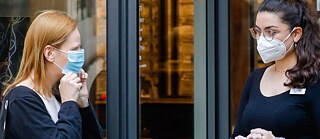Frankly … social
Little Gestures

Speaking from behind a mask – you often can’t understand much. So people find new ways of communicating. Maximilian Buddenbohm has been watching them.
By Maximilian Buddenbohm
The security man at the supermarket is standing at the entrance, looking to check whether all the customers are wearing a mask, as stipulated on signs in the windows. The majority of them do so dutifully, because that’s just how things are with the rules and the situation. People go past him, he nods and nods and waves them through, again and again he does that. Some come in with their masks at half-mast, under their noses, under their chins or even just hanging off one ear – with these people he blocks their way and makes a gesture that no one would have understood a few months ago: he hold his index finger up to his face and traces an arc from chin to nose. It may well turn out to be that this little movement will become established as an internationally understood gesture for obligatory mask wearing, it’s likely to be understood everywhere after this strange year. The people on the receiving end of the gesture then pull their mask up, otherwise they wouldn’t be allowed to shop here. Some people have probably just forgotten to put their mask straight, but of course some people are just seeing what they can get away with, what rules still apply right now and whether maybe you can somehow just slip through. In fact you can get away with a lot in many places, but not in this store, because the man from security is on the lookout and he takes things literally, he follows his instructions.
Choreographed mini-sequences
Then you see some interesting choreography, and that’s new too, they are the dance movements of this season. The security man takes a step back from the person he’s just addressed, places a hand on his heart and bows forward slightly, just a minimal hint. That’s a gesture that isn’t very widespread here. Then he gives the thumbs up and everyone understands this as a thank you, a very friendly one in fact. Of course the security man is wearing a mask too, and as we all know you can’t understand anyone with a mask on. Obviously he’s unenthusiastic about the idea of not being understood a hundred times a day, so he’s simply stopped talking at all. It’s all just mime and gesticulation, that’s effective too. But that isn’t the end of it. You see, not only is it effective – in fact, it works better this way. It’s because this body language is so unequivocally friendly that no one starts long discussions or continues on their way protesting loudly. The people he speaks to just pull up their masks as they are told, then maybe give a thumbs up, and some of them do a little bow too, just a subtle movement, barely visible. But it is there and it's new, it’s a friendly communication without words and we’re only just developing the rules for it.Longer dialogues?
I think about these new movements while I go to the checkout. There’s a queue there and the checkout operator makes a gesture with both her arms, holding them far apart to ask the waiting customers to distance themselves a little more. Then she looks to check and nods when the people arrange themselves slightly differently. Those are just two of the new gestures this year, there are certainly more of them. How many are we likely to know and use by the end of corona? And will we then be able to use them to conduct longer dialogues? If you watch how some customers are encountering each other in the supermarket aisles now, waving their arms wordlessly around to somehow signal that they should go past or give way, the idea doesn’t seem so far-fetched after all.Either way, I’ll keep my eye on it. But for the moment I’ll take a tiny bow, just a hint of one, and finish this article for today.
“Frankly …”
On an alternating basis each week, our “Frankly ...” column series is written by Maximilian Buddenbohm, Qin Liwen, Dominic Otiang’a and Gerasimos Bekas. In “Frankly ... social”, Maximilian Buddenbohm reports on the big picture – society as a whole – and on its smallest units: family, friendships, relationships.